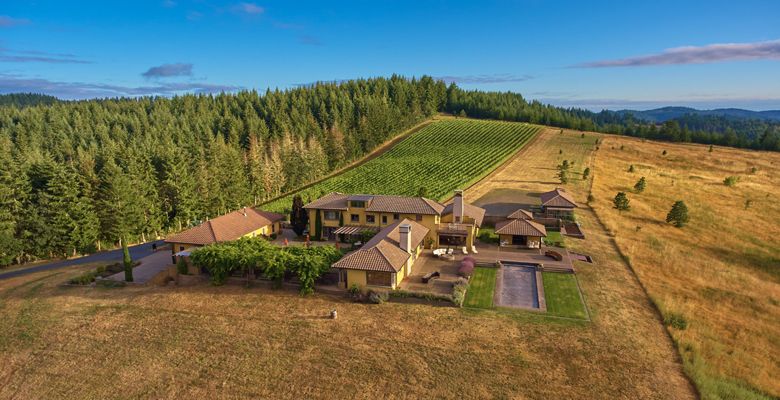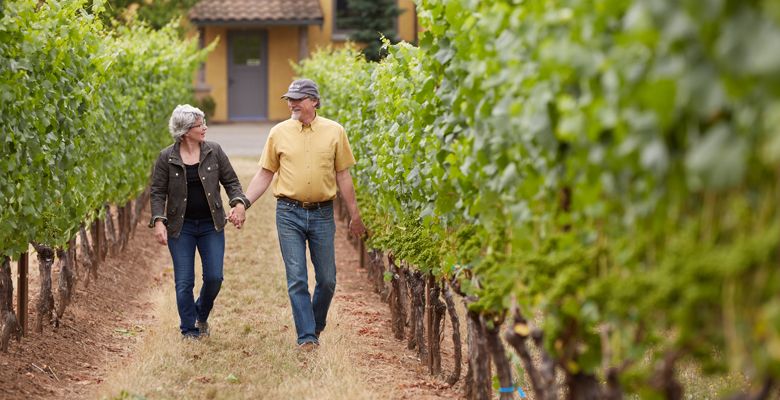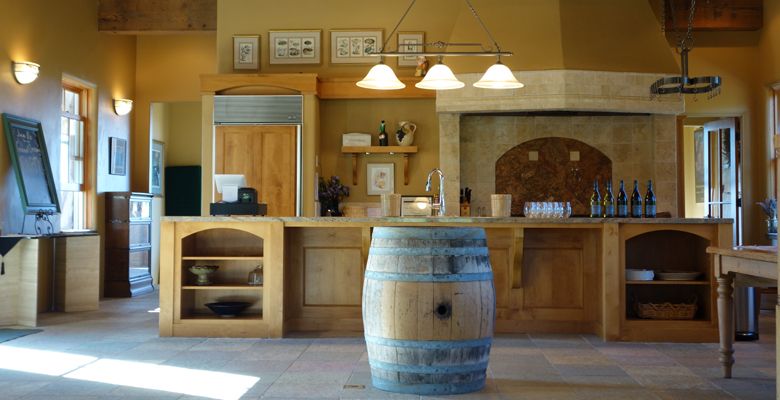Welcome Site
Iris Vineyards a gracious host with worthy wine
By Ken Friedenreich
In gathering narratives about how wineries begin, I’ve found plenty of lore. A common theme remains “by accident.” A couple buys property with vines, and before long, they are pouring their wares at summer festivals, sweating it out under crowded white tents, telling their “story” to consumers eager to hear it. Insouciance, yes, but the truth remains: Buyers can usually tell the difference between Tempranillo plants and tennis courts.
So, when the determination to plant vines reflects consideration and desire, the story may differ in detail, but a good tale surely spins just as readily. Such is the etiology of Iris Vineyards with its Oregon Coast Range foothills vineyard, Chalice Estate, and its first visitor center in the family’s living room — TV moved aside. Now in its third decade, Iris remains as passionate as ever with a serious dedication to its wine legacy in the Southern Willamette Valley, boasting a beautiful tasting room — the covered patio is a must-sit — with memorable views all around.
Founders Richard Boyles and Pamela Frye grew up in the Eugene area and worked offshore after college, yet they returned to the Valley, where a measured relationship to nature allowed “good folks” to prevail — Iris story fits this narrative; for me, this makes Oregon, Oregon.
The couple named the winery for the wild Iris flowers found on the estate. It does seem fitting, though, that Greek mythology’s Iris was not only the rainbow personified but also served libations to the gods of Olympus via the weather phenomenon. The couple’s other brand name comes from the concept of “areté,” a term associated with Aristotle. Areté is a guiding principle representing the activities and character to produce excellence as process — not a post-it note with a slogan scribbled on it.
The wines are crafted in an immaculate facility in Cottage Grove, while the fruit comes mostly from Chalice Estate Vineyard, located about 800 to 1,000 feet up and surrounded by trees replanted by the owners, after a gradual harvesting of lumber — their commitment is restoration, a recalibration of commerce within nature.
The purchase of land and the winery operation itself has been helped by Boyles’ business in a multitude of hotel real estate projects and a hotel management company. As he noted in a response to a questionnaire shared with me, each staff member across his different businesses works not merely to attain goals but to sustain his excellence principle — there’s that “areté.”
Boyles’ judicious approach to wine runs along coherent and identifiable lines. Iris Vineyards’ winemaker, Aaron Lieberman, says frankly, “When we find the need to improve our production capacity or quality, we go out to get what we need.”

Lieberman’s style of winemaking remains reticent, even minimalist; that is, allowing the fruit to lead the way into fruit-forward, acid-balanced and low-alcohol wines. A degreed soil savant from Oregon State University, Lieberman worked in the Peace Corps helping Guatemalans farm more productively before starting his winemaking journey at Amity Vineyards, followed by Owen Roe and his own brand, Cottonwood Winery — no longer in production. In 2008, he joined Iris.
The estate wines, made from more than 43 established acres, provide a gloss on how higher altitudes affect grapes: slower ripening under varied sun exposures, better acid balance and a kind of transparency between minerality and fruit. Varietal characteristics are easy to spot and to appreciate in Iris’ wines.
“I like the fact our elevations lead to long hang-time and slow ripening,” Lieberman says, “because it allows me to guide what I sense the vintage will do rather than override what is already there” — call it laissez-faire viticulture, drawing out from the fruit rather than inserting one’s ego and skill into the wine.
At a definite remove from the farming, the winery staff leaves the vineyard management to the team charged with that responsibility. Accustomed to visitor centers amid rows of vines, we should remember that economies of logistics — financial and otherwise — often segregate the grapes from the places where they transform into wine. Focus and sound practices keep these worlds connected.
The Iris portfolio is not exotic or expensive, so it is a good place to savor how this area of the Willamette Valley makes good wine. The 2016 Pinot Noir, a blend of estate and sourced fruit, represents an intense, full-throated expression of the varietal. We might call it a food soldier since it could pair with grilled meats or salmon steaks. The 2015 Pinot, a blend also, tastes more acidic yet still fruit-forward with a solid feel in mid-palate and a finish that doesn’t leave until tomorrow’s breakfast; its price point is attractive, too.
The estate 2016 Pinot Gris is a complete package but one should let the wine get some oxygen before settling into its allure. On the other hand, the 2017 edition comes out of the chute ready to savor. The fruit-acid balances are dialed in, and it is a wine to stock for serious quaffing or any number of pairings where brightness illuminates the dish at hand.
Chardonnay is another matter. Last year, New York Times wine writer Eric Asimov extolled Oregon Chardonnay as if he were Columbus discovering Chinese take-out when he landed in the New World. Well, the art form eludes many Oregon winemakers still, trying as they do to produce a not-from-California wine that has sex appeal — like Far Niente or Cakebread — but is distinct. I have some favorite Oregon Chardonnay examples that suggest rather than imitate Burgundian whites, and I think Lieberman is working towards such a felicitous outcome. You may see how he’s progressing.
Other wines in the portfolio also call for your respect. These include a 2017 Tempranillo and 2016 Syrah, both releases from Applegate Valley. Both have the heft and the depth preferable in such wines, with mouthfuls of flavor, good body and layered aromas to tempt and please. The Syrah, too, is just fun to view in your glass — regal color and hauteur.
In all, the winery produces about 9,000 cases as of this writing, with a goal of doubling the output within three years. These folks mean business, and they carry on with care and purpose — including ongoing educational and wine tourism industry efforts. Like any business into its third decade, Iris is worth watching both for its good farming practices and above all, the character of its wines that hold promise — at each end of the rainbow.












